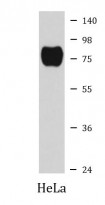ARG42621
anti-Cortactin antibody
anti-Cortactin antibody for Flow cytometry,ICC/IF,IHC-Formalin-fixed paraffin-embedded sections,Immunoprecipitation,Western blot and Human,Mouse,Rat
Overview
| Product Description | Rabbit Polyclonal antibody recognizes Cortactin |
|---|---|
| Tested Reactivity | Hu, Ms, Rat |
| Tested Application | FACS, ICC/IF, IHC-P, IP, WB |
| Host | Rabbit |
| Clonality | Polyclonal |
| Isotype | IgG |
| Target Name | Cortactin |
| Antigen Species | Human |
| Immunogen | Synthetic peptide derived from Human Cortactin. |
| Conjugation | Un-conjugated |
| Alternate Names | EMS1; Amplaxin; Src substrate cortactin; Oncogene EMS1 |
Application Instructions
| Application Suggestion |
|
||||||||||||
|---|---|---|---|---|---|---|---|---|---|---|---|---|---|
| Application Note | * The dilutions indicate recommended starting dilutions and the optimal dilutions or concentrations should be determined by the scientist. | ||||||||||||
| Positive Control | HeLa | ||||||||||||
| Observed Size | ~ 76 kDa |
Properties
| Form | Liquid |
|---|---|
| Purification | Affinity purified. |
| Buffer | PBS (pH 7.4), 150 mM NaCl, 0.02% Sodium azide and 50% Glycerol. |
| Preservative | 0.02% Sodium azide |
| Stabilizer | 50% Glycerol |
| Storage Instruction | For continuous use, store undiluted antibody at 2-8°C for up to a week. For long-term storage, aliquot and store at -20°C. Storage in frost free freezers is not recommended. Avoid repeated freeze/thaw cycles. Suggest spin the vial prior to opening. The antibody solution should be gently mixed before use. |
| Note | For laboratory research only, not for drug, diagnostic or other use. |
Bioinformation
| Database Links | |
|---|---|
| Gene Symbol | CTTN |
| Gene Full Name | cortactin |
| Background | This gene is overexpressed in breast cancer and squamous cell carcinomas of the head and neck. The encoded protein is localized in the cytoplasm and in areas of the cell-substratum contacts. This gene has two roles: (1) regulating the interactions between components of adherens-type junctions and (2) organizing the cytoskeleton and cell adhesion structures of epithelia and carcinoma cells. During apoptosis, the encoded protein is degraded in a caspase-dependent manner. The aberrant regulation of this gene contributes to tumor cell invasion and metastasis. Three splice variants that encode different isoforms have been identified for this gene. [provided by RefSeq, May 2010] |
| Function | Contributes to the organization of the actin cytoskeleton and cell shape (PubMed:21296879). Plays a role in the formation of lamellipodia and in cell migration. Plays a role in the regulation of neuron morphology, axon growth and formation of neuronal growth cones (By similarity). Through its interaction with CTTNBP2, involved in the regulation of neuronal spine density (By similarity). Plays a role in the invasiveness of cancer cells, and the formation of metastases (PubMed:16636290). Plays a role in focal adhesion assembly and turnover (By similarity). In complex with ABL1 and MYLK regulates cortical actin-based cytoskeletal rearrangement critical to sphingosine 1-phosphate (S1P)-mediated endothelial cell (EC) barrier enhancement (PubMed:20861316). Plays a role in intracellular protein transport and endocytosis, and in modulating the levels of potassium channels present at the cell membrane (PubMed:17959782). Plays a role in receptor-mediated endocytosis via clathrin-coated pits (By similarity). Required for stabilization of KCNH1 channels at the cell membrane (PubMed:23144454). [UniProt] |
| Cellular Localization | Cytoplasm, cytoskeleton. Cell projection, lamellipodium. Cell projection, ruffle. Cell projection, dendrite. Cell projection. Cell membrane; Peripheral membrane protein; Cytoplasmic side. Cell projection, podosome. Cell junction. Cell junction, focal adhesion. Membrane, clathrin-coated pit. Cell projection, dendritic spine. Cytoplasm, cell cortex. [UniProt] |
| Calculated MW | 62 kDa |
| PTM | Phosphorylated by PKN2 at both serine and threonine residues in a GTP-bound Rac1-dependent manner in hyaluronan-induced astrocytes and hence down-regulated CTTN ability to associates with filamentous actin (By similarity). Phosphorylated on tyrosine residues in response to CHRM1 activation (By similarity). Phosphorylated by PTK2/FAK1 in response to cell adhesion (By similarity). Phosphorylated by FER. Tyrosine phosphorylation in transformed cells may contribute to cellular growth regulation and transformation. Phosphorylated in response to FGR activation. Phosphorylation by SRC promotes MYLK binding. [UniProt] |
Images (2) Click the Picture to Zoom In







